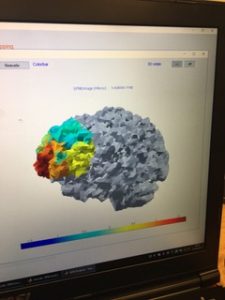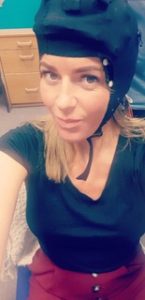Having been asked to detail my experience of the BPS Assistantship scheme, I wanted to highlight not only my participation but also the opportunities that the university affords us.
The BPS Assistantship scheme is offered to students who have completed their second year and are interested in a career in research. It involves, with the help of a supervisor (Rob Bendall in my case), completing a research project over a period of eight weeks, writing up the methods section for an article submission, and submitting a poster to the BPS annual conference.
The initial set up of the experiment with my supervisor really helped cement my understanding of E-Prime software which we covered in 2nd year of psychology. The volume of information that can be input, collected, and linked with other systems opens up so much opportunity for cognitive study. However, I admit it is not an intuitively easy system to use and the detail can get quite technical if you are a bit of a technophobe like myself. The other element to the set-up of the experiment, which I admit I had never thought of, is the level at which extraneous variables need to be considered. With the research in question we needed to examine not only the valence of imagery but also its luminance, contrast, and details such as resolution of images. The minutiae of research are so much wider than you realise until you are involved in the conception of designing an experiment.
Once the initial set-up is complete and you have tested your experiment to ensure it runs smoothly, it is time to look at recruitment. Recruiting for experiments is in theory the easiest part as it just entails sending emails and you expect the offers to come conveniently flooding in. In reality, people wish to come in at the same time, and I needed to focus on my time management and organisation skills to ensure participants were booked in for a suitable period of time, allowing for time between participants should any experiments run over.
Before I talk about the experiment, I will just add in that as part of the experience, I was also asked to curate the Salford psychology twitter account, @SalfordPsych. This was actually the part I was most reserved about due to my technophobia, and I do not have any social media accounts myself. After spending ten minutes looking how to actually post a tweet, I got into it. It is a really useful tool, with members of the faculty posting regularly, links to so many articles from psychologists around the world highlighting the real-world application of many studies, links to events that can be attended, and links to ways of doing charitable work or helping the community. I am definitely signing up for my own account.
Running the experiment was the bit I was most looking forward to and the most surprising factor for me was how many participants were from other schools than the health and social sciences. So many people have an interest in psychology and are wanting to get involved if they are aware (great thing to know when looking for dissertation participants). Being involved has made me aware of the universal interest people have in finding out more about themselves, which is fundamentally what psychology tells us. Running an experiment is easy because it is the same process for all participants, and the testing of the experiment beforehand gave me plenty of confidence in running it. I got to use equipment that I had seen before but never used such as the eye tracker and equipment I had never seen before which was the functional near-infrared spectroscopy (fNIRS) which measures the brains haemodynamic responses.
Even though I was most looking forward to running the experiment, what I enjoyed most was examining the results. The experiment tells us nothing without the results and this is when you learn all the interesting stuff. It amazed me how much data we can actually collect. For our experiment we collected behavioural responses, the fNIRS data, and eye tracking data all of which give a large volume of data. I will admit, this volume of data seemed overwhelming at first but again with a demonstration from Rob and Sam Royle (it must be said after I had an issue with the eye tracker, Sam was very patient), and Aleksandra Landowska for the fNIRS, it was fairly straightforward to extract the data required. I enjoyed analysing the data, but I am a bit of a research methods geek, so I understand that aspect may not be for everyone. But, I defy anyone to not be interested once you begin to see what the data tells us. It is the culmination of all of the work prior and gives a sense of achievement whether the results are significant or otherwise.
I really enjoyed this experience, in fact I enjoyed it so much I asked Rob if I can apply next year also. While I understand that places for this scheme are limited and not everyone will be able to partake, I encourage you to speak with your lecturers about getting involved in their research if this is where your interest lies, or you just want to further your own knowledge of the research experience. There are always experiments taking place throughout university for the research of lecturers, postgraduates, or undergraduates, and assistance is always appreciated. Take advantage of the opportunities that are afforded to us – not only will you be helping yourself, you will be helping others too.

